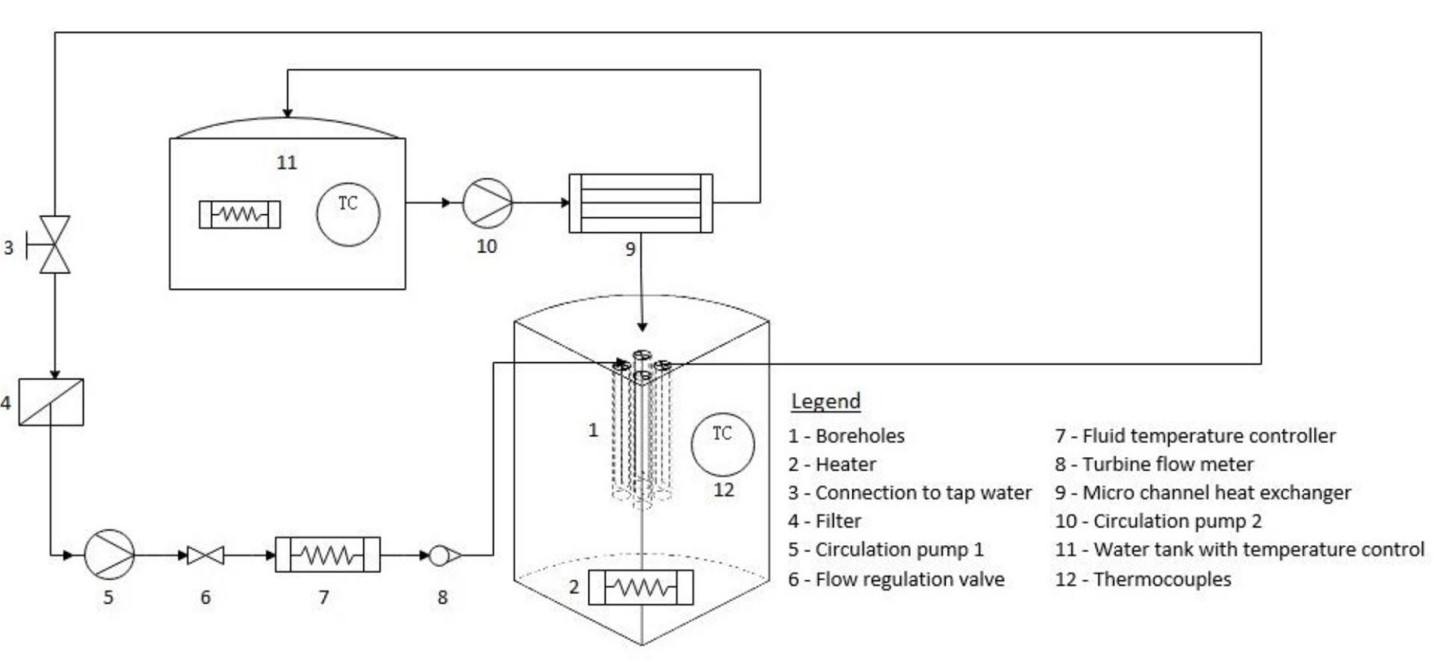LABS – LABoratory Scale model for Borehole Thermal Energy Storage
This laboratory rig has been built to be used as an educational and validation tool applied to heat exchange with the ground in Borehole Thermal Energy Storages.
Long and uncontrolled thermal processes in real installations brings practical difficulties such as data gaps, unknown control strategies, lack of documentation, complex hydrogeological conditions, among others. Such uncertainties result in rarely reported systems in operation as well as a lack of experimental validation tools and laboratory educational set ups. LABS allows performing tests and collecting representative data in a controlled environment on a significantly reduced time scale compared to real size sites.
Background
A lab-scale apparatus was successfully built by Cimmino and Bernier [1] based on a previous work [2]. They obtained an experimental thermal response function that could be compared to a semi-analytical method. In the reviewed literature, this was the only attempt to validate ground heat transfer models on the long-term by the time LABS was build. A discrepancy between the experimental thermal response function and the analytical one was observed, although the difference was comprised within the measurement uncertainty at a 95% confidence level [1]. The authors proposed an explanation for this based on the air temperature variation above the tank, though such a correction did not fully succeed. The work behind LABS proposes another explanation for the difference based on scaling laws and natural convection. Other lab-scale models were constructed although their use was limited to analysis of short-term models or other purposes [3] [4].
Information about the design process, sizing of LABS, and the construction stage, can be found in the publications mentioned below. The work is based on simulation of multiple vertical BHEs, analytical scaling analyses as well as a numerical model which is a modified version of the model presented by Monzó et al. [5]. Some technical, practical and uncertainty limitations are used as constraints to determine the different design parameters.

Aim and objectives
-
Reduce real size long term thermal processes from years to weeks
-
Validate thermal response factors for borehole heat exchangers
-
Educate students about borehole thermal energy storage processes
Researchers
Contact person
Publications
- Construction and Validation of a Lab-scaleBorehole Thermal Energy Storage Model. Dong, Haoyang. Master Thesis. KTH, Skolan för industriell teknik och management (ITM). DiVA.org:kth-308597
- W. Mazzotti, Y. Jiang, P. Monzó, A. Lazzarotto, J. Acuña, and B. Palm, “Design of a laboratory borehole storage model,” 2018.
- W. Mazzotti Pallard, A. Lazzarotto, J. Acuña, B. Palm, “ Design methodology for laboratory scale borehole storage: An approach based on analytically-derived invariance requirements and numerical simulations”. Geothermics, Volume 87, 2020, 101856, ISSN 0375-6505, https://doi.org/10.1016/j.geothermics.2020.101856
- W. Mazzotti Pallard, J. Acuña, A. Lazzarotto, B. Palm, Deep Boreholes for Ground-Source Heat Pump: Final report. 2018. DiVA, id: diva2:1269108. Energimyndigheten, 40934-1.
References
[1] M. Cimmino and M. Bernier, “Experimental determination of the g-functions of a small-scale geothermal borehole,” Geothermics, vol. 56, pp. 60–71, Jul. 2015.
[2] A. Salim Shirazi and M. Bernier, “A small-scale experimental apparatus to study heat transfer in the vicinity of geothermal boreholes,” HVACR Res., vol. 20, no. 7, pp. 819–827, Oct. 2014.
[3] R. A. Beier, M. D. Smith, and J. D. Spitler, “Reference data sets for vertical borehole ground heat exchanger models and thermal response test analysis,” Geothermics, vol. 40, no. 1, pp. 79–85, Mar. 2011.
[4] C. A. Kramer, O. Ghasemi-Fare, and P. Basu, “Laboratory Thermal Performance Tests on a Model Heat Exchanger Pile in Sand,” Geotech. Geol. Eng., vol. 33, no. 2, pp. 253–271, Apr. 2015.
[5] P. Monzó, P. Mogensen, J. Acuña, F. Ruiz-Calvo, and C. Montagud, “A novel numerical approach for imposing a temperature boundary condition at the borehole wall in borehole fields,” Geothermics, vol. 56, pp. 35–44, Jul. 2015.
